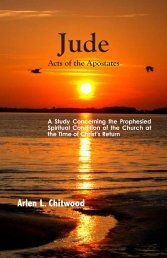Signs in John's Gospel - The Lamp Broadcast
Signs in John's Gospel - The Lamp Broadcast
Signs in John's Gospel - The Lamp Broadcast
Create successful ePaper yourself
Turn your PDF publications into a flip-book with our unique Google optimized e-Paper software.
128 SIGNS IN JOHN’S GOSPEL<br />
Thus, Jesus used a loose-liv<strong>in</strong>g woman, who expressed more<br />
unbelief than belief, <strong>in</strong> order to reach <strong>in</strong>dividuals <strong>in</strong> Samaria.<br />
Though this may not necessarily be the manner <strong>in</strong> which one<br />
might th<strong>in</strong>k of conduct<strong>in</strong>g m<strong>in</strong>istry today <strong>in</strong> order to reach people,<br />
note that stated <strong>in</strong> Isa. 55:8, 9 about the way God does th<strong>in</strong>gs:<br />
“For my thoughts are not your thoughts, neither are your ways<br />
my ways, saith the Lord.<br />
For as the heavens are higher than the earth, so are my ways higher<br />
than your ways, and my thoughts than your thoughts.”<br />
Of course, matters were be<strong>in</strong>g conducted by the One Who could<br />
see the outcome from the beg<strong>in</strong>n<strong>in</strong>g, someth<strong>in</strong>g which Christians<br />
cannot do. But the lesson from John chapter four, <strong>in</strong> the light of<br />
Isa. 55:8, 9, must not be overlooked (evident elsewhere <strong>in</strong> Scripture<br />
as well [e.g., Matt. 21:28-32; Mark 14:3-9; Luke 7:36-50; 19:1-10;<br />
John 8:1-11]).<br />
Attention <strong>in</strong> m<strong>in</strong>istry must be given to the leadership of the<br />
Spirit, which at times, <strong>in</strong> man’s eyes, may not be understood at<br />
all (note, for example, the attitude of the disciples <strong>in</strong> Samaria after<br />
they had returned from the city and had seen what Jesus was<br />
do<strong>in</strong>g [John 4:27; cf. v. 9]). And while follow<strong>in</strong>g the leadership of<br />
the Spirit <strong>in</strong> m<strong>in</strong>istry, one th<strong>in</strong>g above all else must be kept <strong>in</strong> m<strong>in</strong>d.<br />
<strong>The</strong> servant does not have to answer to other servants <strong>in</strong> the<br />
house. That which other servants may th<strong>in</strong>k about a particular<br />
servant’s m<strong>in</strong>istry and the manner <strong>in</strong> which it is be<strong>in</strong>g conducted<br />
is really of little to no moment. <strong>The</strong> f<strong>in</strong>al account<strong>in</strong>g is to one<br />
day be rendered to the Master of the house, not to other servants<br />
<strong>in</strong> the house (cf. John 21:21, 22).<br />
1) Mount Gerizim and Mount Ebal<br />
<strong>The</strong> woman <strong>in</strong> Samaria, dur<strong>in</strong>g the course of her conversation<br />
with Jesus, know<strong>in</strong>g that He was a Jew but realiz<strong>in</strong>g that He<br />
was no ord<strong>in</strong>ary Jew, referred to a mount where the Samaritan<br />
fathers had worshipped. This could only have been a reference<br />
to Mount Gerizim, the site of their destroyed temple. And even<br />
though long s<strong>in</strong>ce destroyed, the Samaritan priests at this time



